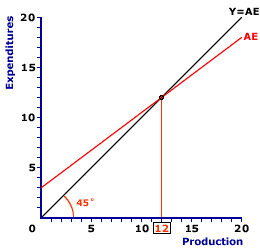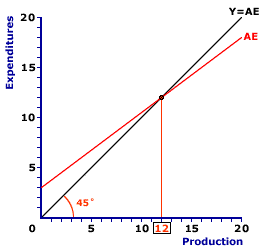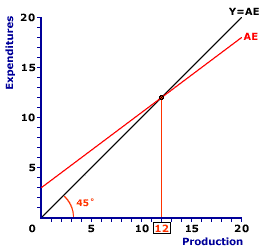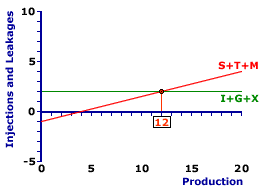
|
|
PERFECTLY ELASTIC: An elasticity alternative in which infinitesimally small changes in price cause infinitely large changes in quantity. In other words, quantity is hyper, super, infinitely responsive to price. Any change in price, no matter how small triggers an infinite change in quantity. Perfectly elastic should be compared with other elasticity alternatives--perfectly inelastic, relatively elastic, relatively inelastic, and unit elastic.
Visit the GLOSS*arama
|
|


|

|
                           KEYNESIAN MODEL: A macroeconomic model based on the principles of Keynesian economics that is used to identify the equilibrium level of, and analyze disruptions to, aggregate production and income. This model identifies equilibrium aggregate production and income as the intersection of the aggregate expenditures line and the 45-degree line. The Keynesian model comes in three basic variations designated by the number of macroeconomic sectors included--two-sector, three-sector, and four sector. The Keynesian model is also commonly presented in the form of injections and leakages in addition to the standard aggregate expenditures format. This model is used to analyze several important topics and issues, including multipliers, business cycles, fiscal policy, and monetary policy. The Keynesian model, commonly presented as the Keynesian cross intersection between the aggregate expenditures line and the 45-degree line, was the standard macroeconomic analysis throughout the mid-1900s, from the Great Depression to the early 1980s. While it was largely replaced by aggregate market analysis (or AS-AD analysis) in the 1980s, it continues to provide important insight into the workings of the macroeconomy.A Keynesian OverviewKeynesian economics is a theory of macroeconomics developed by John Maynard Keynes based on the proposition that aggregate demand is the primary source of business-cycle instability and the most important cause of recessions. Keynesian economics points to discretionary government policies, especially fiscal policy, as the primary means of stabilizing business cycles and tends to be favored by those on the liberal end of the political spectrum.The basic principles of Keynesian economics were developed by Keynes in his book, The General Theory of Employment, Interest and Money, published in 1936. This work launched the modern study of macroeconomics and served as a guide for both macroeconomic theory and macroeconomic policies for four decades. The three key assumptions of Keynesian economics are: - Rigid Prices: Keynesian economics presumes that prices are inflexible or rigid, especially in the downward direction. which can prevent markets from achieving equilibrium.
- Effective Demand: Keynesian economics is also based on the notion of effective demand, the principle that consumption expenditures are based on the disposable income actually available to the household sector rather than income that would be available at full employment.
- Saving and Investment Determinants: Keynesian economics also presumes that factors in addition to the interest rate influence on saving and investment, household saving is based on household income and business investment is based on the expected profitability of production.
A few highlights of Keynesian economics include:- One, the macroeconomy is a distinct entity operating by its own set of principles and that standard microeconomic market principles do not necessarily apply.
- Two, the primary source of business-cycle instability is changes in aggregate demand (or aggregate expenditures) especially investment expenditures.
- Three, markets, especially resource markets, do not automatically achieve equilibrium, meaning full employment is not guaranteed.
- Four, persistent unemployment problems, especially those occurring during the Great Depression, result due to the lack of aggregate demand.
- Five, the recommended way to maintain full employment is through government intervention, especially fiscal policy changes in government purchases.
Four Macroeconomic SectorsThe foundation of the Keynesian model is built on expenditures for aggregate production by the four macroeconomic sectors--household, business, government, and foreign--what are termed aggregate expenditures. The four sectors and their expenditures are:- Household and Consumption Expenditures: The household sector includes everyone in the economy and their purchases of production used for current satisfaction are termed consumption expenditures.
- Business and Investment Expenditures: The business sector includes firms and other entities that produce output and their expenditures on capital goods are termed investment expenditures.
- Government and Government Purchases: The government sector includes federal, state, and local governments and their purchases of the production used to provide government services are termed government purchases.
- Foreign and Net Exports: The foreign sector includes all households, businesses, and governments beyond the political boundaries of the domestic economy and their expenditure contribution is termed net exports, which is the difference between exports and imports.
Keynesian EquilibriumLike most economic models, a key focus of the Keynesian model is equilibrium. In general, equilibrium is the state that exists due to a balance between opposing forces which remains unchanged until another force intervenes. In a market, equilibrium is a balance between the forces of demand and supply. The demand force is buyers wanting a lower price and the supply force is sellers seeking a higher price. For the macroeconomy, equilibrium is a balance between aggregate expenditures (the demand) and aggregate production (the supply).Let's take a closer look at the specifics of equilibrium in the Keynesian model. - First, Keynesian equilibrium is a balance between aggregate expenditures and aggregate production. Aggregate expenditures are the sum of consumption expenditures, investment expenditures, government purchases, and net exports. Aggregate production is the total market value of all final goods and services, as measured by gross domestic product.
- Second, the adjustment mechanism that achieves and maintains equilibrium is aggregate production. If aggregate expenditures are not equal to aggregate production, then aggregate production changes to restore balance. In contrast, the adjustment mechanism for the aggregate market model is the price level. If aggregate demand is not equal to aggregate supply in the aggregate market, then the price level changes to restore balance. In the Keynesian model, the price level is treated as an external force.
- Third, Keynesian equilibrium is ONLY a balance between aggregate expenditures and aggregate production. Other aggregate markets, especially resource markets, need not be in equilibrium. Shortages and surpluses can exist and persist in resource markets. In other words, full employment is NOT automatically achieved with Keynesian equilibrium.
Keynesian Cross| Keynesian Cross |  |
The exhibit to the right is a graphical representation of the basic Keynesian model, commonly termed the Keynesian cross. The "cross" term refers to the intersection between two lines, the red AE line and the black Y=AE line.The vertical axis measures expenditures, specifically aggregate expenditures. The horizontal axis measures production, specifically aggregate production or gross domestic product. This exhibit indicates activity in the macroeconomic product markets, or the aggregate product market. Now consider the two lines. - Y=AE: The black Y=AE line, also termed the 45-degree line, indicates all points in the exhibit in which aggregate expenditures is equal to aggregate production, that is, the demand for gross domestic product is equal to the supply of gross domestic product. It is termed a 45-degree line, because it exactly bisects the 90-degree angle of the two axes and thus the angle formed with either axis is exactly 45 degrees. This further means that the slope of the 45-degree line is not only positive, but equal to 1. If the economy is operating on this 45-degree line, then the aggregate product market is in equilibrium.
- AE: The red AE line, or the aggregate expenditures line, indicates the relation between aggregate expenditures and aggregate production. The aggregate expenditures are the combined expenditures by the four macroeconomic sectors--consumption expenditures by the household sector, investment expenditures by the business sector, government purchases by the government sector, and net exports by the foreign sector. The slope of the AE line is also positive, but less than one. This slope captures the fundamental Keynesian concept of effective demand.
The intersection of the 45-degree line and AE line, which is $12 trillion in this exhibit, is equilibrium. At $12 trillion the aggregate expenditures on production is equal to aggregate production. All four sectors are able to purchase all of the output they want and all output produced is purchased by one of the four sectors. There is neither a surplus nor a shortage of aggregate production.If the economy is not producing the $12 trillion equilibrium level of aggregate production, then it automatically moves to that level. The key to this movement is business inventories (officially termed private inventories). Three VariationsThe Keynesian model comes in three common variations, each based on a different combination of the four macroeconomic sectors.- Two-Sector Model: The simplest Keynesian model includes the household and business sectors. Also termed the private sector Keynesian model, this variation is often used to illustrate the basic operation of the model, including adjustment to equilibrium and the multiplier process. The two-sector model captures the role of induced expenditures through household consumption and the role of autonomous expenditures through business investment.
- Three-Sector Model: Perhaps the most commonly analyzed variation of the Keynesian model adds the government (or public) sector to the household and business sectors contained in the two-sector model. This variation is used to analyze government stabilization policies, especially how fiscal policy changes in government purchases and taxes can be used to close recessionary gaps and inflationary gaps.
- Four-Sector Model: As the name suggests, all four macroeconomic sectors--household, business, government, and foreign--are included in the four-sector Keynesian model. This model is not only used to capture the interaction between the domestic economy and the foreign sector, but also provides the foundation for detailed, empirically estimated models of the macroeconomy.
Full Employment Gaps| Two Gaps | 
|
A key bit of analysis undertaken using the Keynesian model is the relation between equilibrium and full employment. Should equilibrium aggregate production not match the level of aggregate production generated at full employment, two gaps can arise--recessionary gap and inflationary gap.- Recessionary Gap: The first of the two gaps that can arise if equilibrium does not match full employment is a recessionary gap, which is the difference between the equilibrium production and full-employment production that occurs when equilibrium production is less than full-employment production.
To highlight a recessionary gap in this exhibit, click the [Recessionary Gap] button. This reveals a full employment level of production of $15 trillion, which is greater than the $12 trillion equilibrium. The resulting recessionary gap is thus $3 trillion of aggregate production. This is termed a recessionary gap because it arises during a business-cycle contraction or recession in which unemployment is the more pressing problem facing the macroeconomy.
- Inflationary Gap: The second of the two gaps that can arise if equilibrium does not match full employment is an inflationary gap, which is the difference between the equilibrium production and full-employment production that occurs when equilibrium production is greater than full-employment production.
To highlight a inflationary gap in this exhibit, click the [Inflationary Gap] button. This reveals a full employment level of production of only $9 trillion, which is less than the $12 trillion equilibrium. The resulting inflationary gap is thus $3 trillion of aggregate production. This is termed an inflationary gap because it arises during a business-cycle expansion and creates a situation in which inflationary pressure arises, meaning inflation is the more pressing problem facing the macroeconomy.
A key point of the Keynesian model is that the $12 trillion equilibrium level is achieved regardless of full employment. And because $12 trillion is EQUILIBRIUM it will persist once reached. There is no mechanism within the Keynesian model that automatically moves aggregate production to the full employment level.As such, an outside force must intervene to achieve full employment. The recommended Keynesian alternative is stabilization policies, especially fiscal policy. A recessionary gap is closed through the use of expansionary fiscal policy. An inflationary gap is closed through the use of contractionary fiscal policy. The Multiplier| Multiplier | 
|
An important bit of analysis undertaken using the Keynesian model is the multiplier. The basic Keynesian multiplier is the cumulatively reinforcing induced interaction between consumption and production that amplifies autonomous expenditure changes, especially investment, government spending, exports.The essence of the multiplier is that relatively small changes in autonomous expenditures cause relatively large overall changes in aggregate production and income. The resulting changes in aggregate production are typically a "multiple" of the initial expenditure changes, hence the term "multiplier."To see how the multiplier process works, consider the Keynesian cross equilibrium presented here. The aggregate expenditures line (AE) intersects the 45-degree line (Y = AE) at $12 trillion of aggregate production. This production level is bound to change if the aggregate expenditures line shifts. The reason for the change is a $1 trillion increase in government purchases, the result of expansionary fiscal policy. This autonomous change in government purchases is just the thing that shifts the aggregate expenditures line. - To display the shift of the aggregate expenditures line, click the [$1 Trillion More] button. This reveals a new aggregate expenditures line that is $1 trillion higher than the original line.
- The new equilibrium is found at the intersection of the 45-degree line and the new aggregate expenditures line, which is $16 trillion of aggregate production. The difference between the original equilibrium and the new equilibrium is $4 trillion. This is four times the initial change in government purchases, a multiple of the initial change.
The resulting multiplier is based on the marginal propensity to consume. The change in government purchases increases production and income, which then induces changes in consumption according to the marginal propensity to consume. The changes in consumption then cause additional changes in production and income, which then induces more changes in consumption. A larger marginal propensity to consume results in a larger multiplier.The Injections-Leakages Model| The Injections-Leakages Model |  |
A common alternative to the Keynesian cross presentation of the Keynesian economic theory is the injections-leakages model. Whereas the Keynesian cross focuses on the equilibrium balance between aggregate production and aggregate expenditures, the injections-leakages model focuses on the equilibrium balance between injections and leakages.An injection is a non-consumption expenditure on aggregate production, especially investment expenditures, government purchases, and exports. A leakage is a non-consumption use of the income generated from aggregate production, especially saving, taxes, and imports. A balance between injections and leakages generates the same equilibrium as a balance between aggregate expenditures and aggregate production. The exhibit to the right presents the injections-leakages model. The horizontal green line, labeled I + G + X, is the injections line and includes investment expenditures (I), government purchases (G), and exports (X). The positively-sloped red line, labeled S + T + M, is the leakages line and includes saving (S), taxes (T), and imports (M). The intersection of the two lines is the equilibrium level of aggregate production, which matches the equilibrium level of aggregate production generated by the Keynesian cross version of the Keynesian model.

Recommended Citation:KEYNESIAN MODEL, AmosWEB Encyclonomic WEB*pedia, http://www.AmosWEB.com, AmosWEB LLC, 2000-2025. [Accessed: July 18, 2025].
Check Out These Related Terms... | | | | | | | | | | |
Or For A Little Background... | | | | | | | | | |
And For Further Study... | | | | | | | | | | | |
Related Websites (Will Open in New Window)... | |
Search Again?
Back to the WEB*pedia
|



|

|
PURPLE SMARPHIN
[What's This?]
Today, you are likely to spend a great deal of time flipping through mail order catalogs trying to buy either a flower arrangement for your aunt or a birthday greeting card for your uncle. Be on the lookout for rusty deck screws.
Your Complete Scope
This isn't me! What am I?
|

|
|
A lump of pure gold the size of a matchbox can be flattened into a sheet the size of a tennis court!
|

|
|
"A winner is someone who recognizes his God-given talents, works his tail off to develop them into skills, and uses those skills to accomplish his goals. " -- Larry Bird, basketball player
|

|
AAXICO
American Air Export and Import Company
|

|
|
Tell us what you think about AmosWEB. Like what you see? Have suggestions for improvements? Let us know. Click the User Feedback link.
User Feedback
|


|


